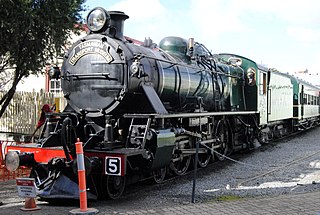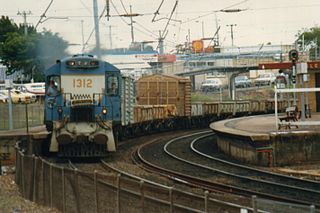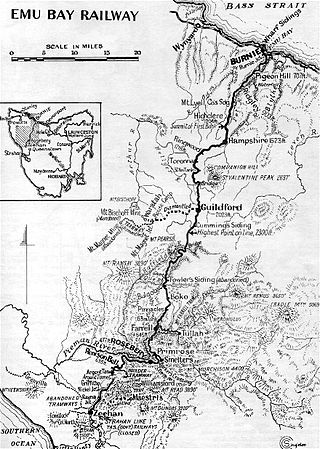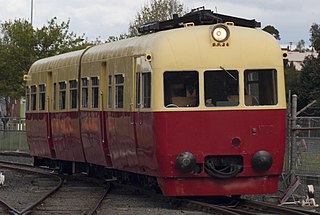| Tasmanian Government Railways Y class | |||||||||||||||||||||||||||||||||||||||||||||||||||
|---|---|---|---|---|---|---|---|---|---|---|---|---|---|---|---|---|---|---|---|---|---|---|---|---|---|---|---|---|---|---|---|---|---|---|---|---|---|---|---|---|---|---|---|---|---|---|---|---|---|---|---|
 Preserved Y3 at the Queen Victoria Museum and Art Gallery, Launceston in June 2013 | |||||||||||||||||||||||||||||||||||||||||||||||||||
| |||||||||||||||||||||||||||||||||||||||||||||||||||
| |||||||||||||||||||||||||||||||||||||||||||||||||||
| |||||||||||||||||||||||||||||||||||||||||||||||||||
| |||||||||||||||||||||||||||||||||||||||||||||||||||
The Y class is a class of diesel locomotives built by the Tasmanian Government Railways between 1961 and 1971.
| Tasmanian Government Railways Y class | |||||||||||||||||||||||||||||||||||||||||||||||||||
|---|---|---|---|---|---|---|---|---|---|---|---|---|---|---|---|---|---|---|---|---|---|---|---|---|---|---|---|---|---|---|---|---|---|---|---|---|---|---|---|---|---|---|---|---|---|---|---|---|---|---|---|
 Preserved Y3 at the Queen Victoria Museum and Art Gallery, Launceston in June 2013 | |||||||||||||||||||||||||||||||||||||||||||||||||||
| |||||||||||||||||||||||||||||||||||||||||||||||||||
| |||||||||||||||||||||||||||||||||||||||||||||||||||
| |||||||||||||||||||||||||||||||||||||||||||||||||||
| |||||||||||||||||||||||||||||||||||||||||||||||||||
The Y class is a class of diesel locomotives built by the Tasmanian Government Railways between 1961 and 1971.
The Y class were designed by English Electric and constructed by the Tasmanian Government Railways' Inveresk Workshops. Eight were built as mainline freight and passenger locomotives between 1961 and 1971. [1]
Following the success of the X class, the Tasmanian Government Railways decided to order additional diesel locomotives.
English Electric submitted plans that were quite similar to the Jamaican Railways 81 class, South Australian Railways 800 class and Midland Railways of Western Australia F class but with a small power increase. They were slightly larger and more powerful than the X class. [1] They had a similar layout to the X class, a long hood unit with the cab at one end.
Construction began at the TGR's Inveresk Workshops in 1961, and three of the planned eight were completed relatively quickly. However, construction of the other five was slow, with the last not being delivered until 1971, by which time the design had become dated.
The Y class were fitted with an English Electric 6SRKT Mark II (Mark III on last two) in-line six turbocharged diesel engine. They have a Bo-Bo wheel arrangement and end-platforms, making them visually different from the X class. [1]
In line with standard TGR practice of the time, they were fitted with hook-and-link couplers and vacuum train brakes (air on locomotive). With a light tractive weight of only 58 tonnes, a reasonably powerful engine of 825 horsepower (615 kW) and a fairly basic bogie design, gaining traction on long uphill grades was found to be difficult. They were noted to have a tendency to wheel-slip badly. Nevertheless, they were considered successful.
In March 1978, the Y class were included in the transfer of the Tasmanian Government Railways to Australian National. With the new transfer of twenty 830 class locomotives from South Australia and later purchase of ZB class and ZC class locomotives from Queensland Rail, the Y class were made redundant.
In the late 1970s and early 1980s, all members of the Y class were retrofitted with stronger automatic couplers, which had by then become standard equipment. Y1 & Y5 also received air train brakes in 1985, [2] with the others withdrawn following the cessation of vacuum braked services in 1988. Most of these were being preserved at this stage. With Y2 going to Derwent Valley Railway, Y3 going to Queen Victoria Museum & Art gallery, Launceston, Y4 to Tasmanian Transport Museum and finally Y6&8 to Don River Railway. With Tasrail retaining Y7 for parts. [3]
Y7 was rebuilt in 2001 as a driving van for use on Railton to Devonport cement trains. With this finally stored in 2017. [4] Two members of the class remained in regular service with TasRail, renumbered as the 2150 class, until mid 2016 when stored out of use.
In May 2022, Y1 (2150) & Y5 (2151) where donated for preservation to Derwent Valley Railway and Launceston & North East Railway respectively. Only leaving DV1, formally Y7, not preserved.
| Image | Original no | Final no | Name | Owner | Status |
|---|---|---|---|---|---|
 | Y1 | 2150 | Derwent Valley Railway | Preserved | |
| Y2 | Henry Baldwin | Derwent Valley Railway | Preserved, operational [5] | ||
 | Y3 | Queen Victoria Museum and Art Gallery, Launceston | Preserved | ||
| Y4 | Rowallan | Tasmanian Transport Museum, Glenorchy | Preserved, operational [6] | ||
 | Y5 | 2151 | Sir Charles Gairdner | Launceston & North East Railway | Preserved |
 | Y6 | Don River Railway, Devonport | Preserved, operational [7] | ||
 | Y7 | DV1 | TasRail | Stored [4] | |
| Y8 | Don River Railway, Devonport | Preserved, derelict [7] | |||

The X class is a class of diesel locomotives built by English Electric for the Tasmanian Government Railways between 1950 and 1952. They were the first class of diesel locomotive to enter mainline service on a Government-owned railway in Australia.

The Tasmanian Government Railways (TGR) was the former operator of the mainline railways in Tasmania, Australia. Formed in 1872, the railway company was managed by the Government of Tasmania, and existed until absorption into the Australian National Railways Commission in 1978.

The NZR WF class were steam locomotives designed, built and used by New Zealand Railways (NZR). Their wheel arrangement is described by the Whyte notation 2-6-4T and the first members of the class entered service in 1904. The locomotives were tank engines designed by the Railways Department's Chief Mechanical Engineer A. L. Beattie, and were mainly built for suburban duties such as those between Christchurch and Lyttelton. They also saw main-line service in the Taranaki region, but most of the class members were assigned to branch line and local services throughout the country. Two were experimentally converted to oil burners in 1909-1910. The tests were satisfactory, but as coal was much cheaper than oil at the time, no further conversions took place.

Rail transport in Tasmania consists of a network of narrow gauge track of 1,067 mm reaching virtually all cities and major towns in the island state of Tasmania, Australia. Today, rail services are focused primarily on bulk freight, with no commercial passenger services being operated. The mainline railways of Tasmania are currently operated by TasRail, a Government of Tasmania-owned Corporation, who owns and maintains both rolling stock, locomotives, and track infrastructure.

The Derwent Valley Railway is an inoperational heritage railway in Tasmania, Australia. Its base is in New Norfolk. It is 3' 6" narrow gauge.

The WAGR X class is a now-withdrawn class of diesel locomotives built by Beyer, Peacock & Company and Metropolitan-Vickers, Bowesfield Works, Stockton-on-Tees for the Western Australian Government Railways (WAGR) between 1954 and 1956. Several members of the class have been preserved.

The Tasmanian Government Railways M class is a class of 4-6-2 steam locomotives operated by the Tasmanian Government Railways.

The 1300 class were a class of diesel locomotive built by English Electric, Rocklea for Queensland Rail between 1967 and 1972. They were later sold to AN Tasrail.

The Emu Bay Railway was a Tasmania, Australian railway company. The railway was significant during full operation, in that it linked the Tasmanian Government Railways system at Burnie with that at Zeehan that further linked to the Mount Lyell railway allowing connection through to Queenstown.

The D/DA class are a class of diesel locomotives built by Clyde Engineering, Granville for the Western Australian Government Railways in 1971-1972.

AN Tasrail was an Australian railway operator that operated the Tasmanian rail network from March 1978 until November 2004. Originally a subsidiary of the Federal Government's Australian National, it was sold to Australian Transport Network (ATN) in November 1997. ATN was acquired by Pacific National in 2004 and the AN Tasrail subsidiary was later acquired by the Tasmanian Government in 2009 to become TasRail.

The Tasman Limited was a passenger train operated by Tasmanian Government Railways (TGR) on the Main and Western lines between Hobart, Launceston and Wynyard from April 1954 to July 1978.
The Z class are a class of diesel locomotives built by English Electric Rocklea for the Tasmanian Government Railways in 1973. They were a development of the WAGR RA class and were the last of a line of very successful locomotives fitted with the English Electric 12CSVT Mk II engine.

The Za class are a class of diesel locomotives built by English Electric Rocklea for the Tasmanian Government Railways in 1973.

The Tasmanian Government Railways H class was a class of 4-8-2 steam locomotives operated by the Tasmanian Government Railways.

The Tasmanian Government Railways R class was a class of 4-6-2 steam locomotives operated by the Tasmanian Government Railways.

The Tasmanian Government Railways V class are a class of diesel locomotives operated by the Tasmanian Government Railways.
Florentine Junction, also known as Pillinger’s Creek, Risby’s Junction, Florentine Rail Yard and Florentine Depot, is the terminus of the Derwent Valley Railway, a 3’ 6” narrow gauge railway that operates from New Norfolk in Tasmania, Australia. The station opened in 1936 but closed in the mid twentieth century when the railway beyond Kallista was closed.

The DQ class were a class of diesel locomotives in New Zealand and Tasmania. Originally built by Clyde Engineering in the 1960s as Queensland Rails 1460 and 1502 class locomotives. They were purchased by Tranz Rail in 1995 to be rebuilt, as a cheaper alternative to buying new locomotives. Tranz Rail rebuilt 16 locos into the DQ class. Tranz Rail then sold the 12 DQs to AN Tasrail. Only eight out of the twelve DQs are still in service today.